MainStage User Guide
- Welcome
-
- Overview of Edit mode
-
- Select patches and sets in the Patch List
- Copy, paste, and delete patches
- Reorder and move patches in the Patch List
- Add and rename patches
- Create a patch from several patches
-
- Overview of the Patch Settings Inspector
- Select patch settings in the Patch Library
- Set the time signature for patches
- Change the tempo when you select a patch
- Set program change and bank numbers
- Defer patch changes
- Instantly silence the previous patch
- Change patch icons
- Transpose the pitch of incoming notes for a patch
- Change the tuning for a patch
- Add text notes to a patch
-
- Overview of channel strips
- Add a channel strip
- Change a channel strip setting
- Configure channel strip components
- Show signal flow channel strips
- Hide the metronome channel strip
- Create an alias of a channel strip
- Add a patch bus
- Set channel strip pan or balance positions
- Set channel strip volume levels
- Mute and solo channel strips
- Use multiple instrument outputs
- Use external MIDI instruments
- Reorganize channel strips
- Delete channel strips
-
- Overview of the Channel Strip Inspector
- Choose channel strip settings
- Rename channel strips
- Change channel strip colors
- Change channel strip icons
- Use feedback protection with channel strips
- Set keyboard input for a software instrument channel strip
- Transpose individual software instruments
- Filter MIDI messages
- Scale channel strip velocity
- Set channel strips to ignore Hermode tuning
- Override concert- and set-level key ranges
- Add text notes to a channel strip in the Channel Strip Inspector
- Route audio via send effects
-
- Screen Control Inspector overview
- Replace parameter labels
- Choose custom colors for screen controls
- Change background or grouped screen control appearance
- Set screen controls to show the hardware value
- Set parameter change behavior for screen controls
- Set hardware matching behavior for screen controls
- Reset and compare changes to a patch
- Override concert- and set-level mappings
-
- Overview of mapping screen controls
- Map to channel strip and plug-in parameters
- Map screen controls to actions
- Map a screen control to multiple parameters
- Use screen controls to display PDF document pages
- Edit the saved value for a mapped parameter
- Set drum pads or buttons to use note velocity
- Map screen controls to all channel strips in a patch
- Undo screen control parameter mappings
- Remove screen control mappings
- Work with graphs
- Create controller transforms
- Share patches and sets between concerts
- Record the audio output of a concert
-
- Overview of concerts
- Create a concert
- Open and close concerts
- Save concerts
- How saving affects parameter values
- Clean up concerts
- Consolidate assets in a concert
- Rename the current concert
-
- Overview of the Concert Settings Inspector
- Set MIDI Routing to channel strips
- Transpose incoming note pitch for a concert
- Define the program change message source
- Send unused program changes to channel strips
- Set the time signature for a concert
- Change the tuning for a concert
- Set the pan law for a concert
- Add text notes to a concert
- Control the metronome
- Silence MIDI notes
- Mute audio output
-
- Layout mode overview
-
- Screen control parameter editing overview
- Lift and stamp screen control parameters
- Reset screen control parameters
- Common screen control parameters
- Keyboard screen control parameters
- MIDI activity screen control parameters
- Drum pad screen control parameters
- Waveform screen control parameters
- Selector screen control parameters
- Text screen control parameters
- Background screen control parameters
- How MainStage passes through MIDI messages
- Export and import layouts
- Change the aspect ratio of a layout
-
- Before performing live
- Use Perform mode
- Screen controls in performance
- Tempo changes during performance
- Tips for performing with keyboard controllers
- Tips for performing with guitars and other instruments
- Tune guitars and other instruments with the Tuner
- The Playback plug-in in performance
- Record your performances
- After the performance
- Tips for complex hardware setups
-
- Overview of keyboard shortcuts and command sets
-
- Concerts and layouts keyboard shortcuts
- Patches and sets (Edit mode) keyboard shortcuts
- Editing keyboard shortcuts
- Actions keyboard shortcuts
- Parameter mapping (Edit mode) keyboard shortcuts
- Channel strips (Edit mode) keyboard shortcuts
- Screen controls (Layout mode) keyboard shortcuts
- Perform in Full Screen keyboard shortcuts
- Window and view keyboard shortcuts
- Help and support keyboard shortcuts
-
-
- Use MIDI plug-ins
-
- Arpeggiator overview
- Arpeggiator control parameters
- Note order parameters overview
- Note order variations
- Note order inversions
- Arpeggiator pattern parameters overview
- Use Live mode
- Use Grid mode
- Arpeggiator options parameters
- Arpeggiator keyboard parameters
- Use keyboard parameters
- Assign controllers
- Modifier controls
- Note Repeater controls
- Randomizer controls
-
- Use Scripter
- Use the Script Editor
- Scripter API overview
- MIDI processing functions overview
- HandleMIDI function
- ProcessMIDI function
- GetParameter function
- SetParameter function
- ParameterChanged function
- Reset function
- JavaScript objects overview
- Use the JavaScript Event object
- Use the JavaScript TimingInfo object
- Use the Trace object
- Use the MIDI event beatPos property
- Use the JavaScript MIDI object
- Create Scripter controls
- Transposer controls
-
-
- Alchemy overview
- Alchemy interface overview
- Alchemy Name bar
- Alchemy file locations
-
- Alchemy source overview
- Source master controls
- Import browser
- Source subpage controls
- Source filter controls
- Source filter use tips
- Source elements overview
- Additive element controls
- Additive element effects
- Spectral element controls
- Spectral element effects
- Pitch correction controls
- Formant filter controls
- Granular element controls
- Sampler element controls
- VA element controls
- Wide unison mode
- Source modulations
- Morph controls
- Alchemy master voice section
- Alchemy Extended parameters
-
- Playback plug-in overview
- Add a Playback plug-in
- Playback interface
- Use the Playback waveform display
- Playback transport and function buttons
- Playback information display
- Playback Sync, Snap To, and Play From parameters
- Use the Playback group functions
- Use the Playback Action menu and File field
- Use markers with the Playback plug-in
-
- Sample Alchemy overview
- Interface overview
- Add source material
- Edit mode
- Play modes
- Source overview
- Synthesis modes
- Granular controls
- Additive effects
- Additive effect controls
- Spectral effect
- Spectral effect controls
- Filter module
- Lowpass, bandpass, and highpass filters
- Comb PM filter
- Downsampler filter
- FM filter
- Envelope generators
- Mod Matrix
- Modulation routing
- Motion mode
- Trim mode
- More menu
-
- Sculpture overview
- Sculpture interface
- Global parameters
- Amplitude envelope parameters
- Use the Waveshaper
- Filter parameters
- Output parameters
- Define MIDI controllers
- Extended parameters
-
- Studio Piano
- Copyright

Create zones with drag and drop in MainStage
A zone is a location into which a single audio file—or sample, if you prefer this term—can be loaded. The sample loaded into the zone is memory resident—it uses the RAM of your computer. You can define as many zones as needed.
A zone offers parameters that control sample playback. You can set the key range—the range of notes that the sample spans—and the root key—the note at which the sample sounds at its original pitch for each zone. In addition, you can adjust sample start, end, and loop points, volume, and several other parameters for the zone.
Sampler provides several methods you can use to create and add zones. You can quickly add a single zone to Sampler by dragging an audio file or Apple Loop to the Mapping or Zone panes. You can create multiple zones by dragging multiple audio files or loops onto the Sampler Mapping pane or Navigation bar. You can also manually create a zone and can add an audio file by using menu options. You can also choose whether the new zone maps samples chromatically or based on analysis of the material.
Important: When you drag a region to the track header area or to another drag zone to create a sample-based software instrument using the region, the region is bounced through the plug-ins on the track. For software instrument tracks, this includes any MIDI plug-ins, the track instrument, and any audio plug-ins. For audio tracks, this includes any audio plug-ins and other processing, such as Flex. The resulting audio file is used in the sample-based instrument. This is different than dragging an audio file to a drag zone, which does not trigger a bounce.
Create a zone by dragging content into the zone pane
In MainStage Sampler, click the Zone button in the Navigation bar to view an empty Zone pane.
To add material from the Finder:
Drag an audio file or Apple Loop into the Zone pane.
The root key for the zone is the key at which the sample is played at its recorded pitch.
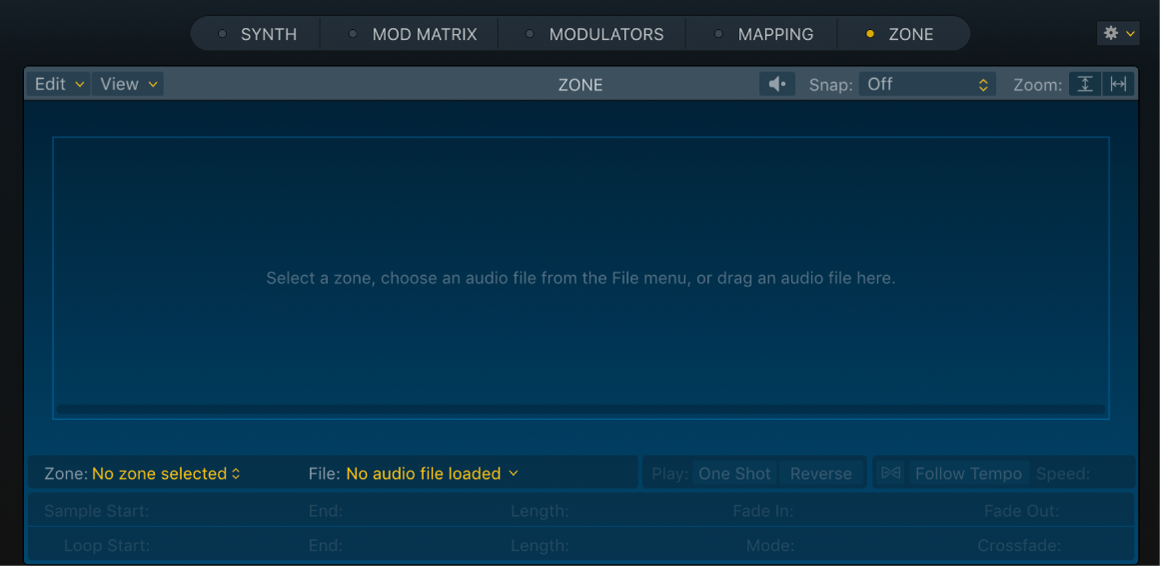
Create a zone by dragging content to one or more keys
In MainStage Sampler, click the Mapping button in the Navigation bar to view an empty Mapping pane. Click the Key Mapping Editor button if not already shown.
From the Finder:
Drag an audio file or Apple Loop directly onto a key on the Mapping pane keyboard.
The root key is shown in gold on the keyboard. The start key, end key, and root key are all set to the note that the file is dragged to.
Note: You can drag multiple audio files onto a key in the Key Mapping Editor. This automatically creates a stack of layered zones, split by velocities.
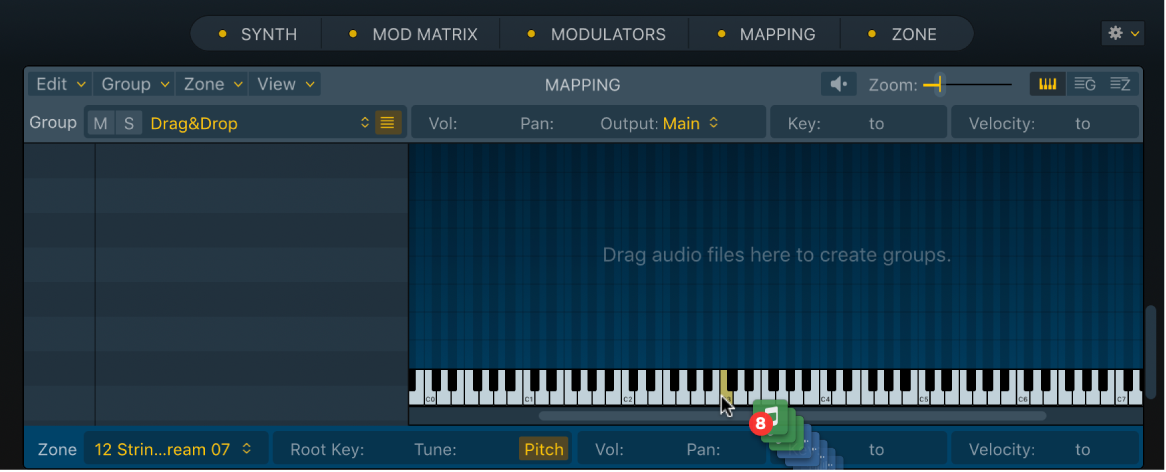
The drop location changes the import behavior:
When you drop an audio file onto the keyboard, it is mapped to that key.
When you drop an audio file onto the Key Mapping Editor above the keyboard, it is mapped to a range of keys. As you drag toward the top of the Key Mapping Editor, the key range expands.
The root key is shown in gold, and the key range (containing the start key and end key) is shown across the keyboard.
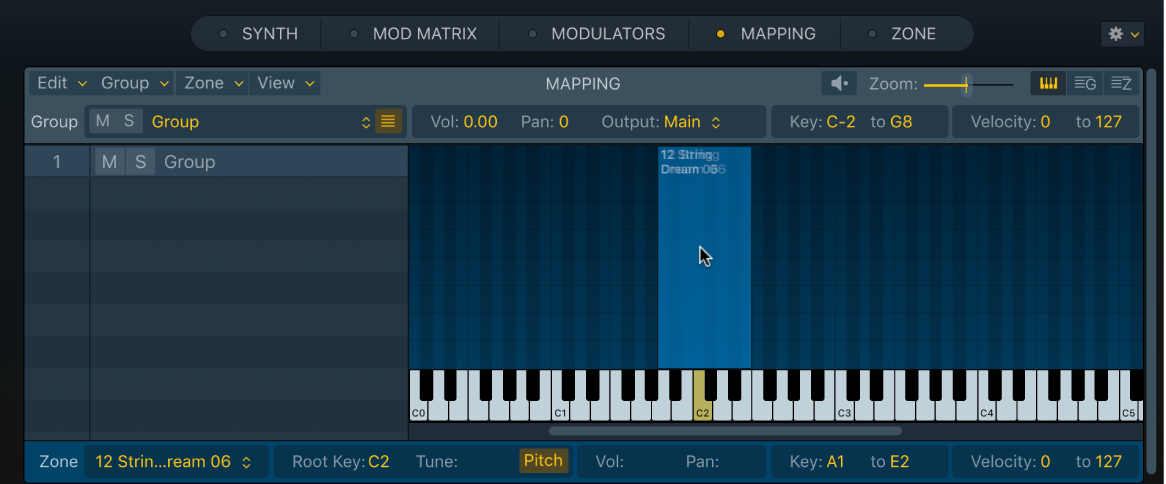
Add multiple files to the Key Mapping Editor
In MainStage Sampler, you can add audio files to the Mapping pane in several ways and in different editor views.
Click the Mapping button in the Navigation bar to view an empty Mapping pane. Click the Key Mapping Editor button if not already shown.
From the Finder:
Drag one or more files into the Mapping pane, either directly onto the keyboard or the Key Mapping Editor above the keyboard. Shift-click or Command-click to select multiple files.

The drop location changes the import behavior:
When you drop an audio file onto the keyboard, it is mapped to that key. When you drop multiple audio files onto the keyboard, each is mapped to its own key.
The root key is shown in gold on the keyboard. Multiple gold keys are shown when you drag more than one audio file.
When you drop an audio file onto the Key Mapping Editor above the keyboard, it is mapped to a range of keys. As you drag toward the top of the Key Mapping Editor, the key range expands.
The root key is shown in gold, and the key range is shown across the keyboard. Multiple gold keys and key ranges are shown when you drag more than one audio file.
Add multiple files to the Zone view and create a new group
In MainStage Sampler, you can add audio files to the Mapping pane in several ways and in different editor views.
Click the Mapping button in the Navigation bar to view an empty Mapping pane. Click the Zone view button if not already shown.
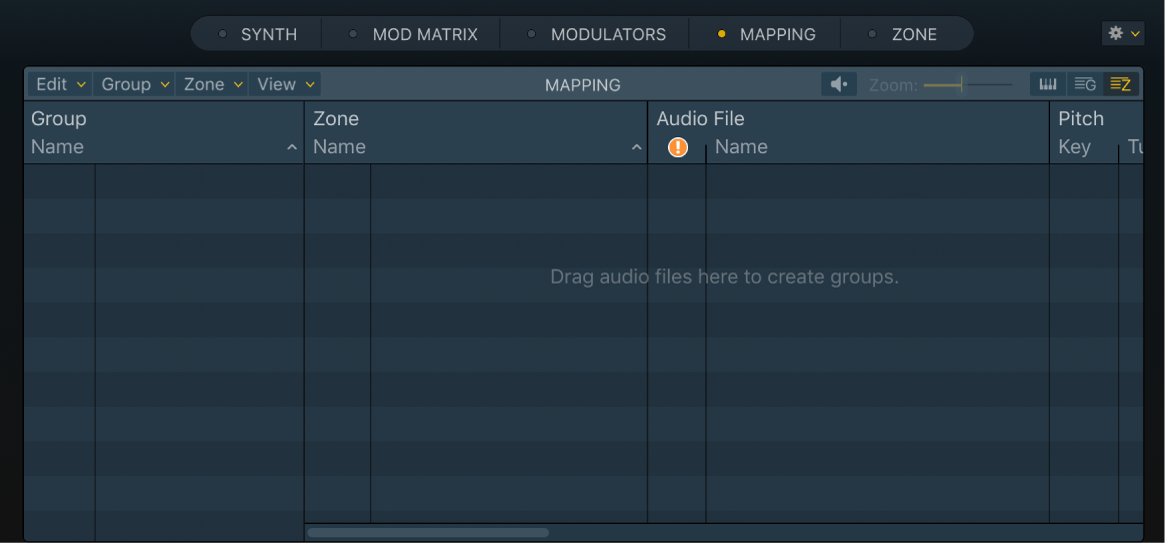
From the Finder:
Drag one or more files onto the Zone view. Shift-click or Command-click to select multiple files.
A group is automatically created and the audio file is added to the group. When you drop multiple audio files, all are added to the group.

Create a new, empty instrument
In MainStage, insert Sampler into an instrument channel.
Click the Mapping or Zone buttons (or both) in the Navigation bar to turn on these panes, if they are not shown.

Click the Mapping button in the Navigation bar to view an empty Mapping pane. You will typically add audio files in either the Key Mapping Editor, Navigation bar, or Zone view, but you can also drop files into the Group view or Zone pane.
Click the Key Mapping Editor button to add audio files in the Key Mapping Editor.
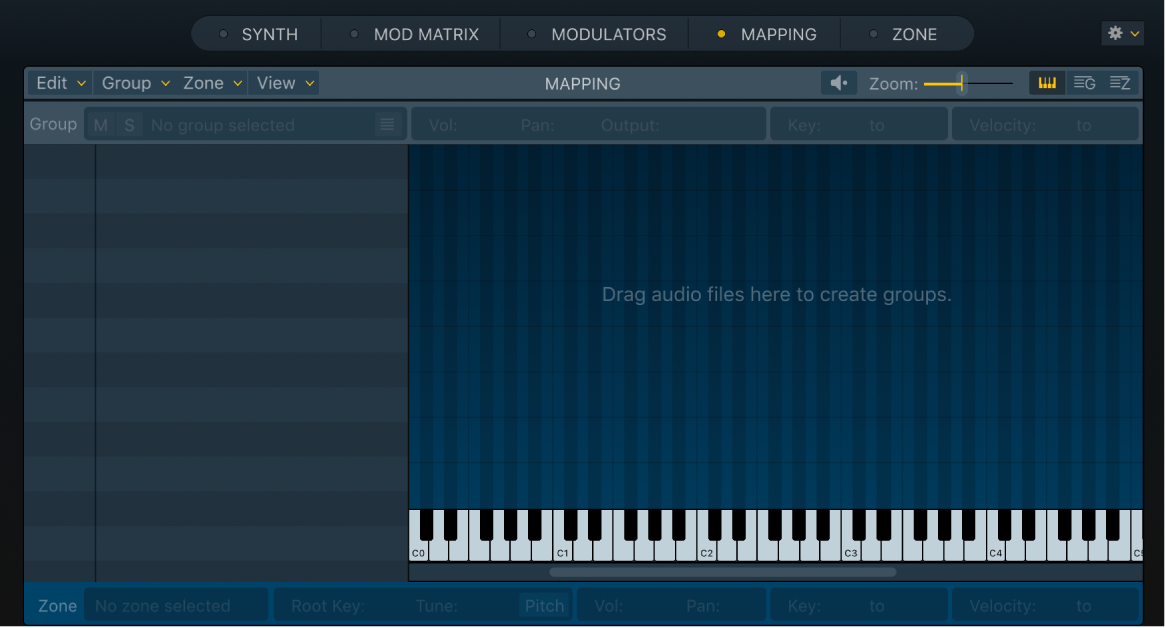
Click the Zone view button to add audio files in this view.

Create an empty zone with a menu command, and assign a sample to it
In the MainStage Sampler Mapping pane, choose Zone > New.
A new group is shown in the Mapping pane, and a zone is automatically added to the group.

Do one of the following:
In the Zone pane, drag an audio file into the waveform display area.

In Zone view, click the File column, then choose Load Audio File from the pop-up menu.
In Zone view, drag an audio file into the empty Name field of the zone in the Audio File column.

In the Key Mapping Editor, press and hold Command-Shift, then drag the pointer to create a new, empty zone. You can add a sample to the zone using any of the methods discussed.
In the Key Mapping Editor, drag an audio file directly onto the zone.

If you chose the Load Audio File option in step 2, locate the audio file you want and select it in the File Selector window.
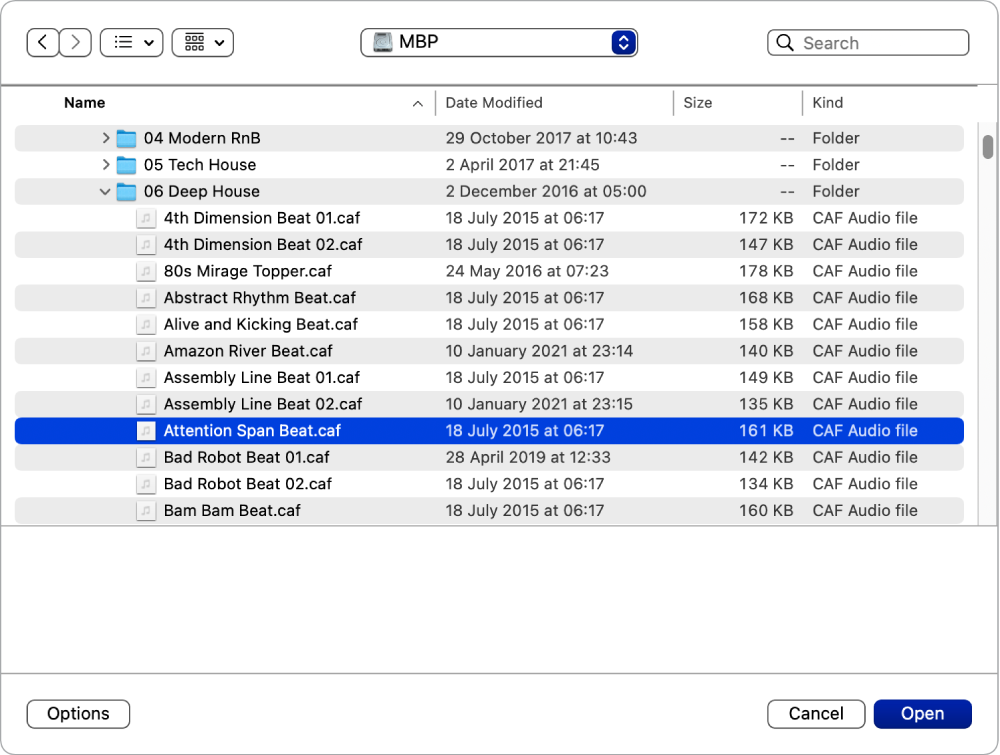
Click the Options button at the lower left of the File Selector window to show or hide the checkboxes and Play button.
Select “Hide used audio files” to dim the names of files used in the currently loaded sampler instrument.
Select “Preview audio file in Sampler Instrument” to temporarily replace the sample files in the currently selected zone. The zone is not directly triggered by selecting this option, but it can be triggered by playing MIDI notes while the File Selector window is open—and different files are chosen. The selected sample can be heard as part of the zone, inclusive of all synthesizer processing (filters, modulation, and so on).
To preview looped playback of the currently selected audio file, click the Play button at the lower right of the File Selector window. The Play button label changes to Stop during playback.
You can step through files by using the Down Arrow key, or by clicking them, to audition each file in turn.
Click the Stop button to stop playback.
When you find an audio file you want to use, click the Open button to add it to the zone.
When the audio file is loaded, the sample name is displayed in the Name field for the zone in the Audio File column of Zone view.